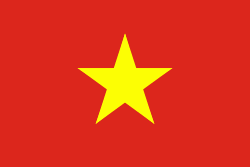Chi Lăng District (Huyện Chi Lăng)
Chi Lăng is a rural district of Lạng Sơn province in the Northeastern region of Vietnam. It is famous for many decisive battles at Chi Lăng pass in which the Vietnamese defeated the Chinese invaders.
As of 2003, the district had a population of 77,910. The district covers an area of 703 km². The district capital lies at Đồng Mỏ.
Chi Lăng pass was the site of many battles between feudal Vietnam and northern armies. Lý Thường Kiệt, Trần Hưng Đạo and Lê Lợi were among the army leaders that won battles in the district. Nowadays, many streets and places across Vietnam are named after the Chi Lăng pass, most notably the Chi Lăng Stadium in Da Nang.
Chi Lang district is located in the south of Lạng Sơn province, 106 km from Hà Nội city, 35 km from Lạng Sơn city, with the geographical location:
* East: borders Lộc Bình district
* North: borders Cao Lộc, Văn Quan districts and Lạng Sơn city
* West: border with Văn Quan district
* Southwest: borders Hữu Lũng district
* South: borders Lục Ngạn district, Bắc Giang province.
Chi Lăng district has an area of 707.45 km², and the population in 2019 is 75,063. The district capital is Dồng Mỏ town, located on the National Route 1.
As of 2003, the district had a population of 77,910. The district covers an area of 703 km². The district capital lies at Đồng Mỏ.
Chi Lăng pass was the site of many battles between feudal Vietnam and northern armies. Lý Thường Kiệt, Trần Hưng Đạo and Lê Lợi were among the army leaders that won battles in the district. Nowadays, many streets and places across Vietnam are named after the Chi Lăng pass, most notably the Chi Lăng Stadium in Da Nang.
Chi Lang district is located in the south of Lạng Sơn province, 106 km from Hà Nội city, 35 km from Lạng Sơn city, with the geographical location:
* East: borders Lộc Bình district
* North: borders Cao Lộc, Văn Quan districts and Lạng Sơn city
* West: border with Văn Quan district
* Southwest: borders Hữu Lũng district
* South: borders Lục Ngạn district, Bắc Giang province.
Chi Lăng district has an area of 707.45 km², and the population in 2019 is 75,063. The district capital is Dồng Mỏ town, located on the National Route 1.
Map - Chi Lăng District (Huyện Chi Lăng)
Map
Country - Vietnam
 |
 |
| Flag of Vietnam | |
Vietnam was inhabited by the Paleolithic age, with states established in the first millennium BC on the Red River Delta in modern-day northern Vietnam. The Han dynasty annexed Northern and Central Vietnam under Chinese rule from 111 BC, until the first dynasty emerged in 939. Successive monarchical dynasties absorbed Chinese influences through Confucianism and Buddhism, and expanded southward to the Mekong Delta, conquering Champa. The Nguyễn—the last imperial dynasty—surrendered to France in 1883. Following the August Revolution, the nationalist Viet Minh under the leadership of communist revolutionary Ho Chi Minh proclaimed independence from France in 1945.
Currency / Language
| ISO | Currency | Symbol | Significant figures |
|---|---|---|---|
| VND | Vietnamese đồng | ₫ | 0 |
| ISO | Language |
|---|---|
| KM | Central Khmer language |
| ZH | Chinese language |
| EN | English language |
| FR | French language |
| VI | Vietnamese language |















